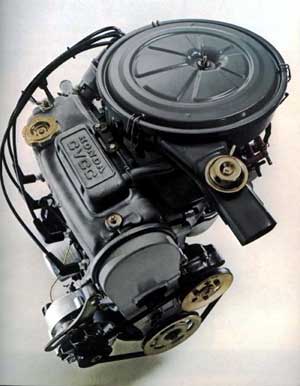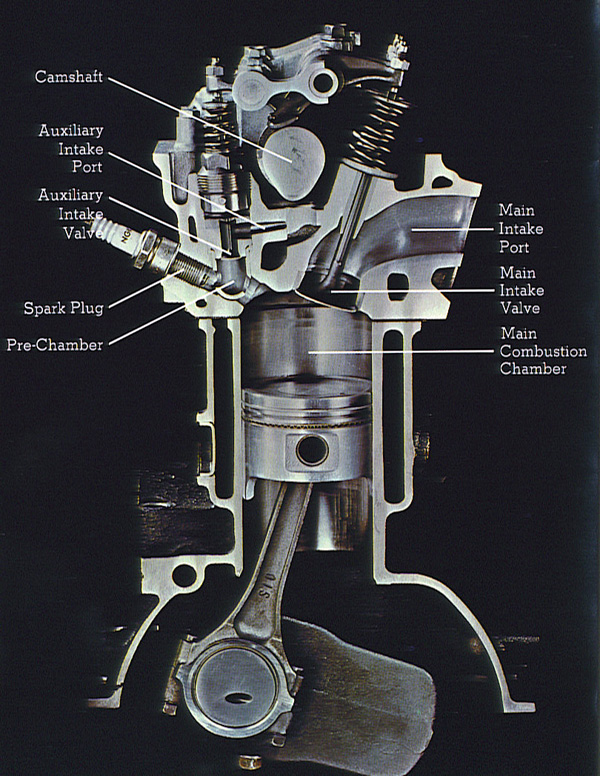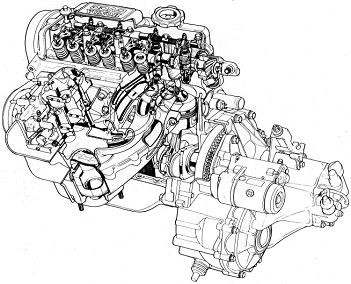|
CVCC means Compound vortex controlled combustion.
The CVCC engine debuted in 1975.
Offered alongside the standard Civic engine, the 53-horsepower CVCC
engine displaced 1,488 cc and had a head design that promoted
cleaner, more efficient combustion. The CVCC design eliminated a
need for a catalytic converter or unleaded fuel to meet emissions
standards. (Nearly every other U.S. market car for this year
underwent the change to exhaust catalysts and the requirement to use
only unleaded fuel.) Due to California's stricter emissions
standards, only the Civic CVCC was available in that state. A
five-speed manual gearbox became available this year, as did a Civic
station wagon (only with the CVCC engine).
A CVCC engine has a special cylinder head.
The CVCC head uses a stratified charge combustion chamber. A
stratified combustion mixture is richer at the sparkplug and much
leaner at the main part of the combustion chamber. The rich mixture
is easily ignited by the sparkplug and this initial flame will
ignite the remaining leaner mixture. The CVCC head uses a
pre-combustion chamber that is about the size of a thimble. The CVCC
carburetor is actually two carburetors in one, a lean part and a rich part. The
lean part feeds the main combustion chamber and the rich part feeds
the pre-combustion chamber. The rich mixture in the pre-combustion
chamber is ignited . A "flame hole" in the pre-combustion
chamber allows the pre-combustion flame to blow across the regular
combustion chamber and ignite the lean mixture.
|
  There are two basic ways for simultaneously lessening the amount of carbon monoxide, unburned hydrocarbons, and oxides of nitrogen in the exhaust of internal combustion engines: (1) Cleaning up the exhaust by means of a catalyst or other add-on devices, or (2) Employing a very lean overall mixture (excess oxygen) and regulating its combustion to suppress production of the unwanted pollutants. Conventional and rotary engines
uses the first method. The Honda CVCC engine uses the second. There are two basic ways for simultaneously lessening the amount of carbon monoxide, unburned hydrocarbons, and oxides of nitrogen in the exhaust of internal combustion engines: (1) Cleaning up the exhaust by means of a catalyst or other add-on devices, or (2) Employing a very lean overall mixture (excess oxygen) and regulating its combustion to suppress production of the unwanted pollutants. Conventional and rotary engines
uses the first method. The Honda CVCC engine uses the second.
The Conventional Engine
The conventional engine operates best with an air-fuel mixture that is on the rich side. If the mixture is made too lean, the engine will begin to misfire because a lean mixture is difficult to ignite with a spark plug.
To meet the 1975 California standards, the conventional rich mixture system generally requires the addition of an
air pump and either a catalytic converter or a thermal reactor to reduce the emission of unburned hydrocarbons and carbon monoxide. In addition, some engines require exhaust gas
re-circulation to limit production of oxides of nitrogen.
 The CVCC Engine The CVCC Engine
The CVCC engine is designed so that a very lean overall mixture can be burned. The regulated burning of this lean mixture with its excess of oxygen enables the CVCC system to meet the 1975 California standards without the addition of the air pump, catalyst, or exhaust gas
re-circulation required by most other engines.
Structure of The CVCC Engine
Each cylinder in the CVCC engine has two chambers; a main combustion chamber, and a pre-chamber.
Each of these chambers has its own inlet valve. A spark plug ignites the mixture in the pre-chamber. Connecting the pre-chamber with the main combustion chamber is an opening designed to direct the flame from the pre-chamber into the main combustion chamber.
How The CVCC Engine Operates
 |
 |
 |
 |
 |
 |
Suction Stroke
On the intake stroke, a large amount of very lean mixture is drawn through the main intake valve into the main combustion chamber. At the same time, a very small amount of rich mixture is drawn through the auxiliary intake valve into the pre-chamber. |
Compression Stroke
At the end of the compression stroke, a rich mixture is present in the pre-chamber, a moderate mixture is formed in the main combustion chamber near the pre-chamber outlet, and a very lean mixture is present in the remainder of the main combustion chamber. |
Ignition
When the spark plug fires, the rich mixture in the pre-chamber is easily ignited. |
Expansion Stroke
The flame from the pre-chamber ignites the moderate mixture and this, in turn, ignites the lean mixture in the main combustion chamber. The formation of carbon monoxide is minimized because of this lean mixture. |
Bottom Dead Center
The stable and slow burning in the main combustion chamber has two desired effects. The peak temperature stays low enough to minimize the formation of oxides of nitrogen. And the mean temperature is maintained high enough and long enough to substantially reduce hydrocarbon emissions. |
Exhaust Stroke
The hot gases exit through the exhaust valve, and oxidation continues in the manifold. |
|

